Discover 9 hidden attractions, cool sights, and unusual things to do in Milford Haven (United Kingdom). Don't miss out on these must-see attractions: Milford Haven Museum, Torch Theatre, and St Thomas à Becket Chapel. Also, be sure to include South Hook Fort in your itinerary.
Below, you can find the list of the most amazing places you should visit in Milford Haven (Wales).
Table of Contents
Milford Haven Museum
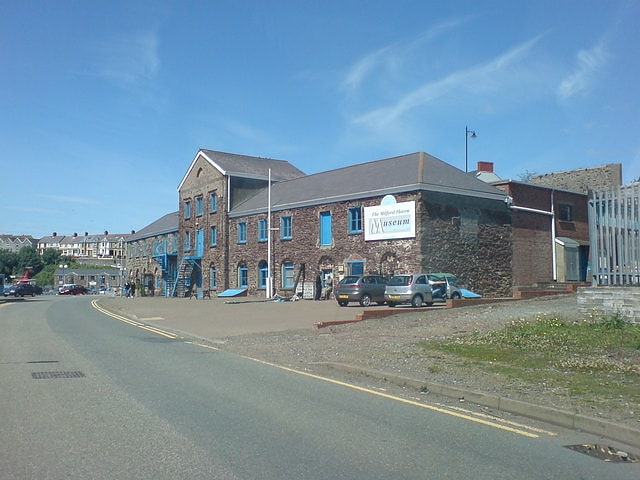
Museum in Milford Haven, Wales. Milford Haven Museum is a maritime and heritage museum in Milford Haven, Pembrokeshire. Opened in 1991, it has a heavy focus on the maritime history of the town, with exhibitions which explore the fishing and oil industries in the area. The collection also contains information relating to the railway industry in the area, Milford at war, the shipbuilding industry and the Liquefied Natural Gas process. Summer 2013 saw the arrival of a rare Bronze Age wooden trough, discovered locally at St Botolphs in 2006.
The museum is located centrally in the docks area, and is housed in the town's oldest building, the Custom House, which dates back to 1797. A Grade II listed building made of rubble stone, it was designed by Swansea architect, Jernigan, and built for the storage of whale oil. In 2009 the museum was awarded national quality museum standard.[1]
Address: Milford Marina The Docks, SA73 3AA Milford Haven
Torch Theatre
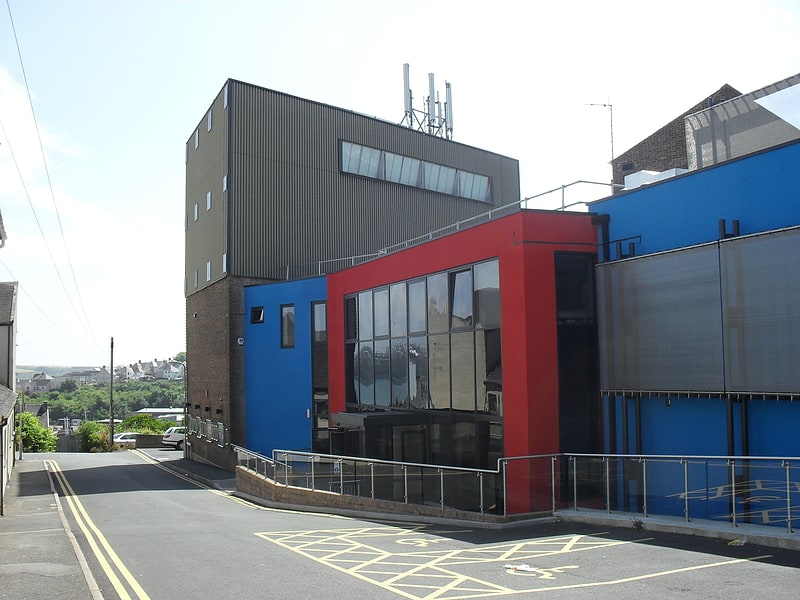
Theatre in Milford Haven, Wales. The Torch Theatre is a not-for-profit theatre in Milford Haven, Wales.
Established in 1977, it is one of only three building-based producing theatres in the whole of Wales. The initial concept was a small community enterprise, linked with a Further Education centre in the adjacent building. Expansion however meant that it became a much larger project. The theatre was designed by local architect, Monty Minter. It was built at a cost of £500,000, and opened with a production of Relatively Speaking. As well as hosting touring productions, the Torch possesses its own independent theatre company which produces and tours its own shows. Since the late 1980s, it has been the only cinema in the town.
In 2006, the theatre commenced a £5.4 million redevelopment. In August 2007, Milford Haven Town Council voted to cut the grant it provides to the theatre, which in turn will affect the much more substantial income from the Arts Council of Wales.[2]
Address: Milford Haven, St. Peter's Road
St Thomas à Becket Chapel
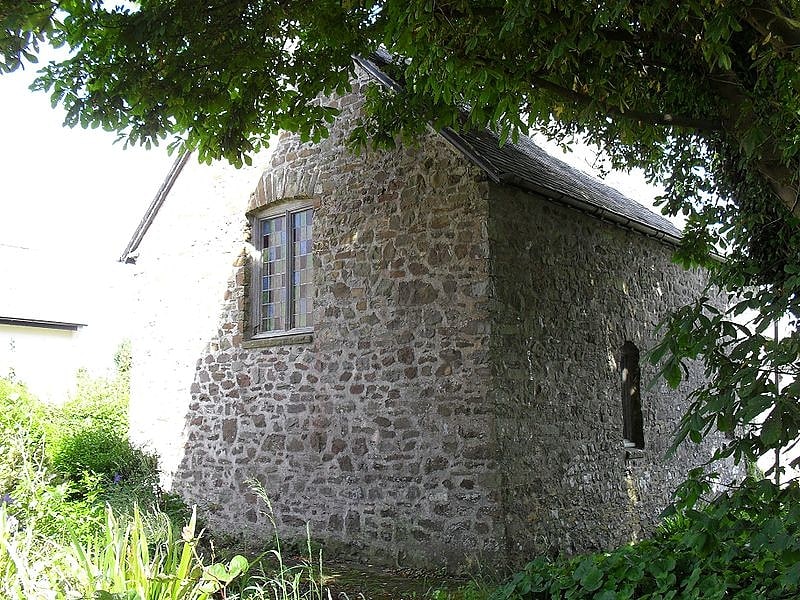
St Thomas à Becket Chapel is a Grade II listed building situated in the town of Milford Haven. It was constructed in 1180 and dedicated to St Thomas Becket. It commanded fine views of the Haven estuary, situated on the north bank in open space. Along with two other chapels, now disappeared, at Herbrandston and St Anne's Head, it functioned not only as a Catholic place of worship, but also as a Beacon Chapel, or lighthouse to sailors. The chapel enjoyed a dependent relationship with the nearby Pill Priory. By the 17th century the structure was in ruins, when it was occupied by Parliamentarian forces in 1644. It later acquired a function as storage for the battery located on the Rath.
In the twentieth century, it had become used as a pigsty and stable. In 1930, £1,000 was raised, and the building was reconstructed, work completed in 1938. It was re-consecrated as an Anglican chapel of ease. It is built of rubble stone with a graded slate roof, small nave and chancel, both with pointed barrel vaults. The interior is simple with plastered vaults, small niches each side in chancel and a curved rood beam with rood. The nave south facing windows have stained glass of 1935 and 1939 to Sir Hugh Thomas of Castle Hall. In 2012 it was privately sold, in spite of local opposition.[3]
South Hook Fort
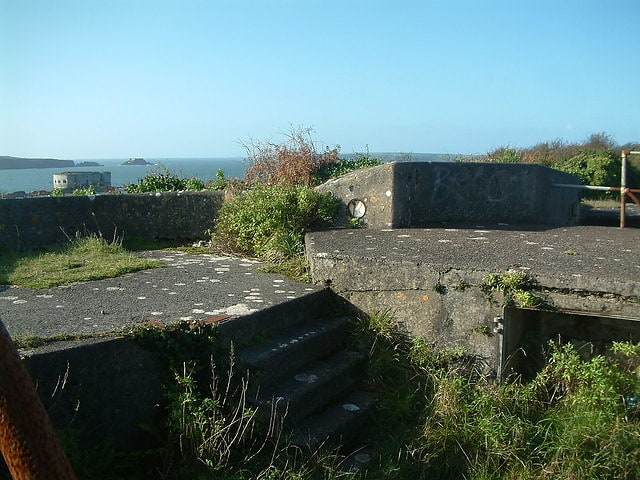
South Hook Fort, on the northern shore of Milford Haven, Pembrokeshire, is a Grade II*-listed building which belongs to a series of forts built as part of the inner line of defence of the Haven following the Royal Commission on the Defence of the United Kingdom.
Work commenced on the fort in 1859, a year before the Royal Commission was published. The fort later became part of the double defences of the Haven and was built to a similar design as that at Hubberstone. It is D-shaped with four walls 4 feet thick and contains a horseshoe shaped two-storey barracks block. It comprises two separate batteries protected by earthworks and connected to the fort by covered walkways. The fort initially housed twenty guns facing out to sea, although this was later modified. It is surrounded by a deep ditch, and access is via a bridge. Work was completed in 1865. Its complement included a Defence Electric Light searchlight unit manned by 200 men, and its guns were aligned to provide crossfire with those at Hubberston and Popton across the Haven. The fort was fully manned during the First World War, although it was abandoned in the 1930s. It was sold in 1936 but requisitioned in 1939 by the Admiralty and called HMS Skirmisher. During the Second World War, it was manned by WRENS controlling naval movements in the Haven. After the war it was once again decommissioned, and returned to private ownership. It now part of the South Hook LNG terminal jetty.[4]
Fort Hubberstone
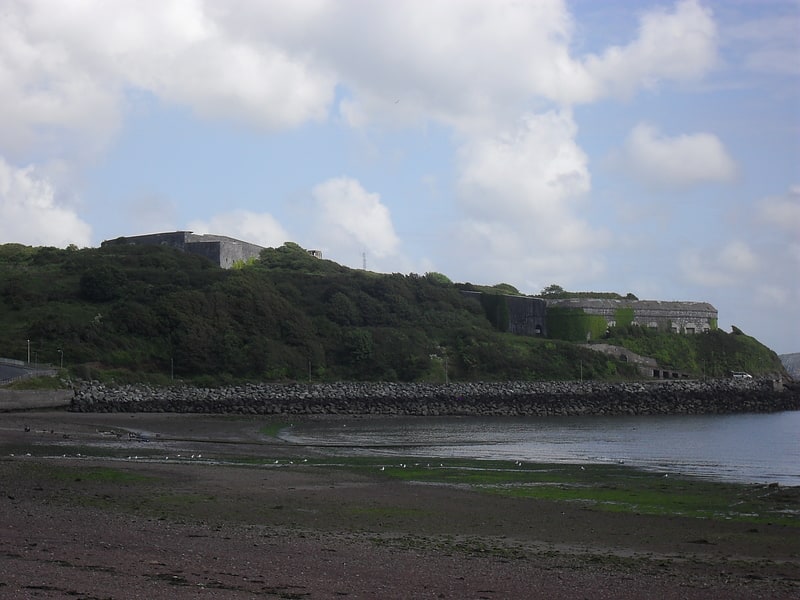
Building in Wales. Fort Hubberstone, on the west side of Milford Haven, Pembrokeshire, is a Grade II* Listed Building which belongs to a series of forts built as part of the inner line of defence of the Haven following the Royal Commission on the Defence of the United Kingdom. Together with Popton Fort on the opposite shore, it provided an interlocking field of fire, and represented the last layer of defence before reaching the Royal Naval dockyard at Pembroke Dock. Construction began in 1860 and was completed in 1863 at a cost of £55,000. It is a large battery, with eleven guns in casemates, eight in an open battery above, with another nine in an open flank battery, and a large barracks to the rear. It is a D-shaped structure, with a bomb-proof roof which protected the barracks and other buildings from mortar projectiles. On its landward side, it was protected by a deep ditch, and on the seaward side by a counter-scarp gallery. The associated casemate battery is located further down the headland and separated from the fort.
The barracks had capacity for 250 men, sourced from the Royal Pembrokeshire Artillery and the 24th Regiment of Foot. Recruitment however was frequently constrained by the isolation of the fort, lacking the appeal of more urban stations. The fort was often required to fire live practice rounds, and in 1894 participated in experiments to illuminate targets with searchlights so they could be engaged at night. Notoriously, in 1875 Lieutenant Walter of the militia was murdered by a Doctor Alder in a drunken brawl.
The fort was abandoned after World War I as a consequence of the Haldane Reforms. A 1919 proposal to convert the structure into social housing came to nothing. World War II saw the fort once again in active use, when it was used as an air raid shelter and army camp for American military personnel.
On a good site, the fort has fallen into disrepair. Under the ownership of Milford Haven Port Authority, there were various unsuccessful plans to restore the structure. The site is not currently open to the public, and has been the scene of non-fatal injuries to trespassers. In 2011 it was named as the fifth most endangered archaeological site in the UK by British Archaeology, which prompted a campaign to seek a long-term sustainable use of the site. In 2019, plans were announced to convert the site into a military-based residential camp for former service men and women. These plans were subsequently dropped due to a media scandal involving Camp Valour. In September 2020, the site was purchased by a private investor, who announced it would be open it to the public as a ‘living ruin’.[5]
Pill Priory

Priory. Pill Priory is a Tironian house founded near Milford Haven, Pembrokeshire, South West Wales in the late 12th century.
Pill Priory was founded as a daughter house of St Dogmaels Abbey (raised to Abbey status in 1120), near Cardigan, itself a priory of the Tironensian order of reformed Benedictine monks. The other daughter houses were Caldey (Caldey Island, Pembrokeshire, Wales) and Glascarrig, County Wexford in Ireland.
Pill Priory was established by the Roche family of the Barony and Roch Castle, Pembrokeshire and was founded within a few years of St Dogmaels. The founder was Adam de la Roche, a descendant of Godebert de Fleming. E.M. Pritchard thought it to be around 1180–90, while the Pembrokeshire antiquarian Richard Fenton considered the earlier date of 1160–70 to be possible.
The priory was jointly dedicated to the Blessed Virgin Mary and to St Budoc, a dedication of it was the former chapel of St Budoc (now "St Botolph") which lay 1.3 km north-east of Pill Priory.
The community may always have been small; it was recorded as five monks in 1534 and four in 1536.
The priory site and its environs, including five orchards, a wood and a meadow at Pill, the priory mill and several other possessions including St Budoc's and Steynton Church were demised by the crown to John Doune who, in 1544, confirmed the grant of his interest to John Wogan who in turn had been the lessee of the "Priory" in 1536–7.
In 1536 St Dogmaels Abbey and its daughters at Pill and Caldey were dissolved in the suppression of those monastic houses with values of less than £200 and fell to the crown. The Valor Ecclesiasticus recorded that Pill Priory was worth annually £67 15s. 3d. gross, £52 2S. 5d. net after charges. The manor of Pill, including the priory site and associated holdings, was sold in June 1546 to the aspiring local landowners Roger Barlow of Slebech and his brother Thomas.
An account of Pill Priory by the Pembrokeshire antiquarian Richard Fenton, writing c. 1811, describes the priory ruins much as they survive today.
The entire site remains in private hands. The free-standing remains of the priory church's chancel arch is now the most striking element of the site, and forms a garden feature, together with the remains of the south transept. The Pill Priory Cottage living quarters contain elements from the conventual buildings which were arranged around a more-or-less formalised cloister. The remains of all are constructed from Old Red Sandstone and Carboniferous Limestone, both from local sources.
The chancel arch and south transept are designated as scheduled monuments by Cadw (the Welsh Government historic environment service). The living quarters are listed as Grade II*.[6]
RNMD Milford Haven
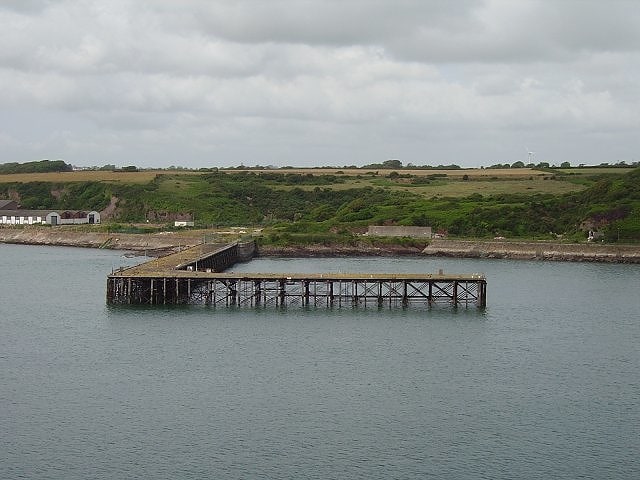
RNMD Milford Haven is a decommissioned Royal Naval Armaments Depot located on the north shore of Milford Haven between Milford Haven and Llanstadwel in the County of Pembrokeshire, Wales. The area is known as Newton Noyes.[7]
Scoveston Fort

Historical landmark in Wales. Scoveston Fort, on the northern shore of Milford Haven, Pembrokeshire, Wales, U.K. is a Grade II Listed Building which belongs to a series of forts built as part of the inner line of defence of the Haven following the Royal Commission on the Defence of the United Kingdom. Built on high ground to the north east of the town of Milford Haven, it commands excellent views of the surrounding countryside, and was the only fort around the Haven to be built inland.
The original recommendation from the commission was to build 6 defensive forts to protect the Haven from attacks from the north. Following a review by government, this was reduced to the site at Scoveston only, which would protect the towns of Milford Haven and Neyland. Construction commenced in 1861 and completed in 1864 at a cost of £45,462. The structure is hexagonal, surrounded by a 36-foot-wide escarpment. It is surrounded by a rampart with a caponier on each corner. The rear face was defended by an earthen bank, and a large traverse was erected across the length of the interior parade ground. Entrance to the fort is via a drawbridge and a tunnel through a small gorge.
The fort was designed as a garrison for 128 men, and was designed to have a complement of 32 guns. Cost and the declining requirement for forts in the twentieth century meant that guns were never installed. It was never garrisoned, and was used mainly as a training camp for volunteers and militia. World War I saw increased activity in the fort. In order to protect the dockyards of Milford Haven, Neyland and Pembroke Dock, a complex system of trenches was built in the land surrounding the fort to ward against land based attack. The trench system ran from Waterston to Llangwm.
During World War II, it was used as an air raid shelter by residents of Neyland. It was later used as a warehouse to store munitions in readiness for D-Day. During peacetime, it was left empty, under the care of a single caretaker. It was revealed following his conviction that serial killer John Cooper had visited the fort and had deposited items which he had stolen from nearby properties, and implements he had used to restrain victims. In August 2005, a local doctor committed suicide close to the fort. The fort is currently in an overgrown state, and not accessible to the public.[8]
South Hook LNG terminal

South Hook LNG terminal is an LNG regasification terminal near Milford Haven and is the largest LNG terminal in Europe. Together with the smaller Dragon LNG terminal it can handle up to 25% of the UK's gas requirement. The first tanker docked on 20 March 2009.[9]